
Weel…this was great fun to wake up to! Herself found my humble blog. And thank you to all my new followers! Stay tuned for more eye candy… erm…anatomy!
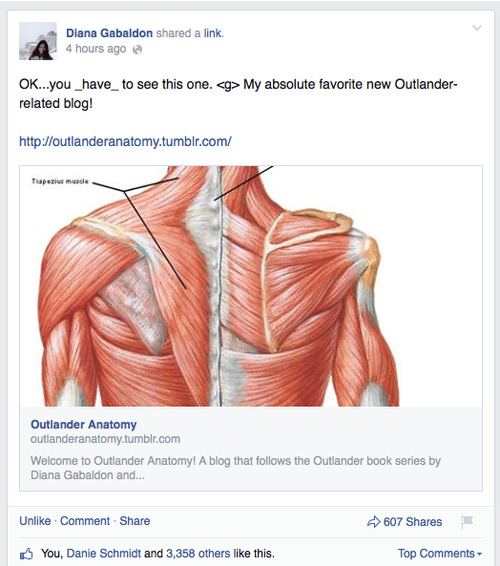

Human Anatomy taught through the lens of the Outlander books by Diana Gabaldon and the Starz television series

Weel…this was great fun to wake up to! Herself found my humble blog. And thank you to all my new followers! Stay tuned for more eye candy… erm…anatomy!

Hallo, anatomy students! Anatomy Lesson #2 dealt with Jamie’s dislocated shoulder. Today’s Anatomy Lesson #3 delves deeper into the shoulder region. Why? Because Jamie’s bad-day blues continue with a gunshot wound to his already battered shoulder (Starz episode 1, Sassenach).
Take a wee peek at the lad’s bonny shoulders in Starz episode 5, Rent. Mo’ bettah? The shoulder is fully healed, thanks to Nurse Claire. Jamie is super unhappy here, as Uncle Dougal uses and abuses him for political expediency (some things never change. Hah!). Let’s see the damage done to his shoulder by the musket ball.
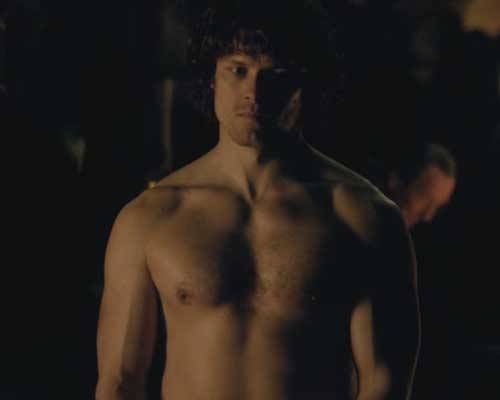
To understand Jamie’s gunshot wound, we must explore more shoulder anatomy:
Clavicle: Anatomy Lesson #2 introduced the paired clavicles (collar bones), each a strut holding its shoulder joint away from the torso. Here is how they works: each clavicle lies mostly horizontal at the top of the chest where its near (proximal) end attaches to sternum (breast bone) and its far (distal) end attaches to acromion (Image A – right side). Both ends are secured in place by ultra-strong ligaments.
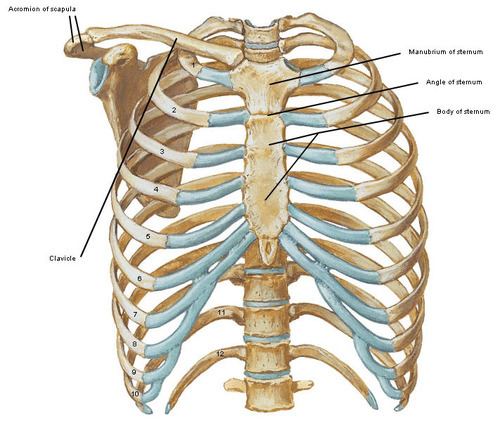
Image A
Firmly grounded to the torso via the sternum, the clavicles support most of the weight of our shoulders. If a clavicle breaks, then the shoulder joint droops and the patient presents supporting his/her injured side with the good hand. Here is a great example of a broken left clavicle in the form of wee Ferris Bueller (Image B). Oops, mea culpa, Mathew Broderick, not the charming high school con artist. BTW, this photo isn’t movie magic. In 2006, Matthew fell off a horse while riding in Ireland, breaking his clavicle!
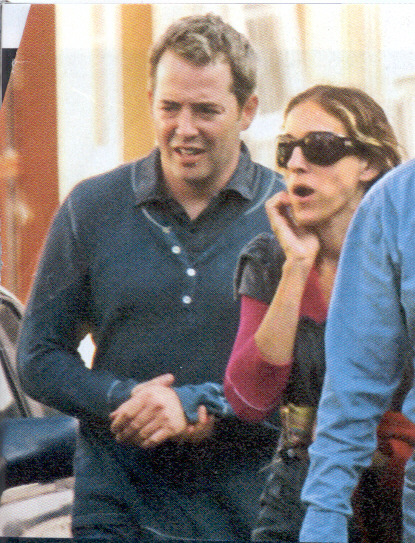
Image B
Trapezius: The clavicle is also a landmark for reviewing the second injury to our “king of men!” Below the clavicle lies the chest, above it is the trapezius muscle, here seen overlaid with skin (Image C).
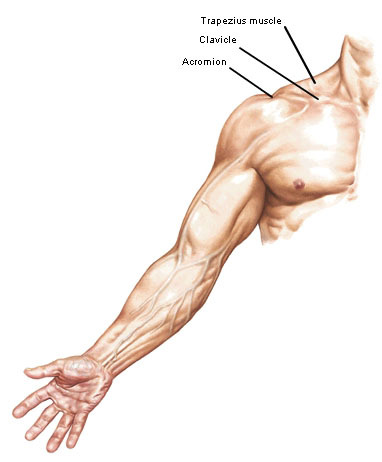
Image C
When the “Mad Bastard Randall” whipped JAMMF for defending his sister, Jenny (episode 2, Castle Leoch), both loverly clavicles are visible in an otherwise unloverly situ! Two flesh ridges are created by the clavicles as Jamie’s poor arms tied in place. Hurtful humiliation for the laird’s son!
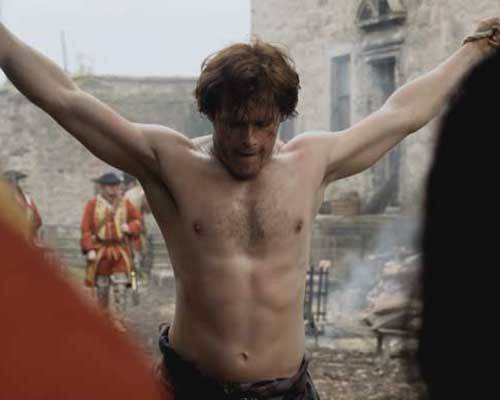
Bad Day: Now, on to Jamie’s second owie of a verra bad day! You will recall the wee stramash with redcoats at Cocknammon Rock, where Jamie unceremoniously dumps Claire in the dirt, rips off his belt sling (och, that hurts!), and yells “hide yerself?” Course, ye do.
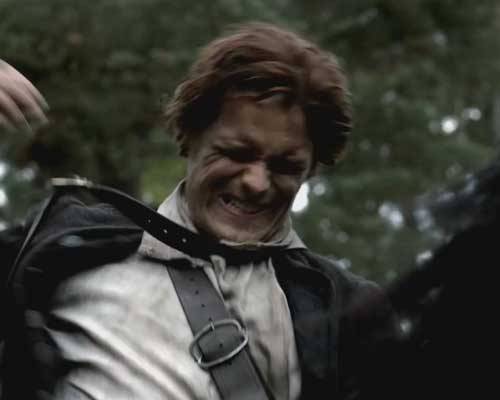
No Dummy: Being a smart sassy-lass, Claire immediately high tails it downstream where Jamie catches her up. Sliding off his steed (I’ll return to that splendid image in a future lesson), he cautiously approaches: sword drawn, arms extended, speaking gently – corralling her like one of his horses. Whoa, Nellie!
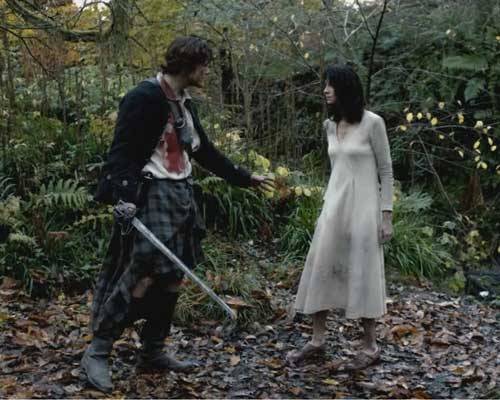
Claire’s Feign: Claire tries distracting Jamie from her aborted flight by changing the subject – she hopes he hasn’t been misusing that shoulder! Geeze, Claire, ya think? Jamie looks like mayhem – bloody, muddy, disheveled and in HIGH DUDGEON! But, her ploy isn’t gonna work on Jamie – the lad’s as bright as a ruddy sunbeam! Glancing at his shirt, Jamie dismisses the bloody mess as belonging mostly to the other guy.
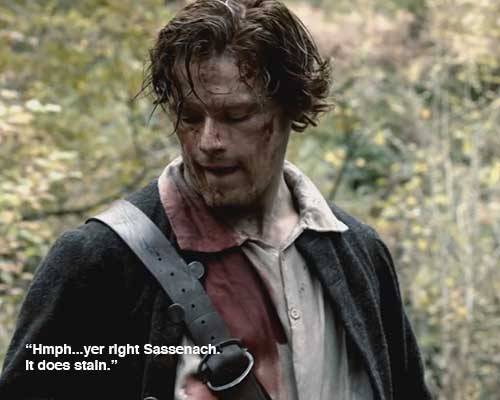
Jamie warns Claire that she is coming with him because Dougal and his band of Merry Men are waiting further upstream. “You don’t look that heavy” he mutters cautiously creeping toward her – LIAR, LIAR Pants on Fire! In Outlander book, Jamie later tells Claire she weighs as much as a good draft horse <G>!
Feral cat that she is, Claire spits that she isn’t going with him. Just look at her face. You gonna make me?
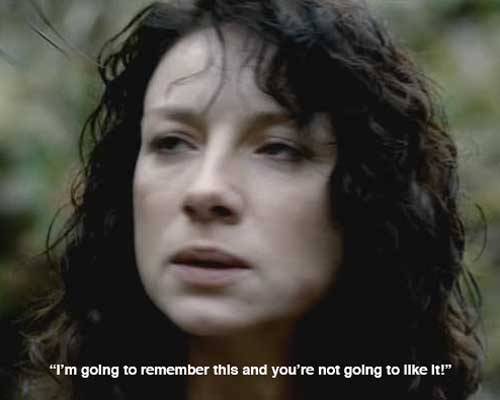
Well, yeah, he is. Jamie warns she better get her sweet arse into that saddle or he is gonna pick her up and thrown her on it!
Now, Mistress Beauchamp, a wee word of advice: we all ken that ye are a braw and fearless lass who isn’t scairt to take a STAND but don’t bait the puir man in his present condition – battle causes Jamie to take his own kind of STAND! Ye ken? So, off they go…clip clop.
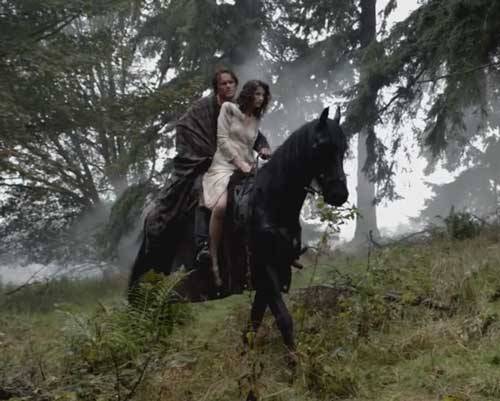
After nightfall, Claire yells “Help, he’s going over” and, having fainted, Jamie hits the ground with a mighty thud. Och, he is 6’4” and weighs 15 stone = 210 pounds!
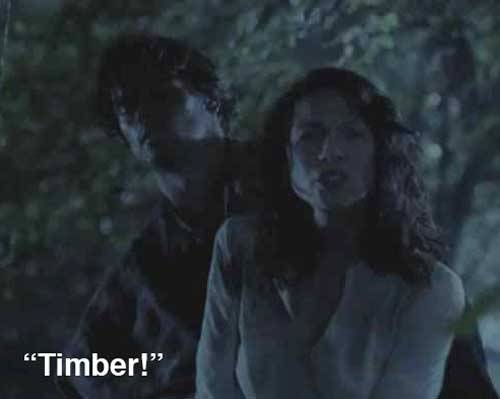
“Help me lift him up!” and “Come on!” our bossy nurse orders the highlanders as they pull his head and shoulders onto a small hillock.
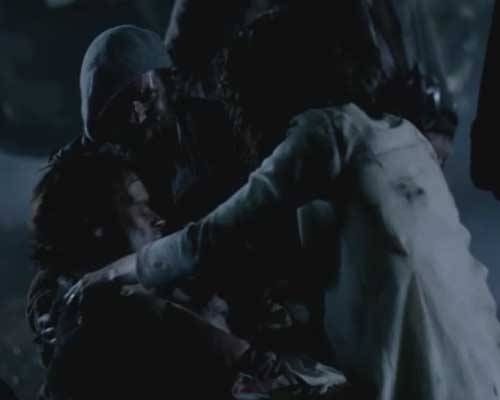
STOP – time for a teaching moment!
Not wanting to create my own stramash, but, writers of Starz episode 101, Sassenach, got this one wrong: no nurse worth her/his grit would ever order the head of a fainted patient to be lifted above the level of the heart! NO WAY! Why? Well, a person faints because blood pressure to the brain falls below the level required for consciousness. So, a competent practitioner either raises the feet or lowers the head or both! Gravity then helps move blood back into the brain and if all goes well, consciousness is restored.
Now, giving credit where credit is due, Herself got it right in Outlander book where Claire orders the lads to put a saddle bag under Jamie’s feet, thus aiding blood flow from the lower body towards the head.
Moving on: Claire pulls aside Jamie’s shirt and quickly diagnoses a nasty gunshot wound. Ew! The shot went cleanly through the trapezius muscle just above the collar bone (In Outlander book, a bayonet does the dastardly deed), but either way, enough loss of blood that our tapaidh (brave) hero faints.
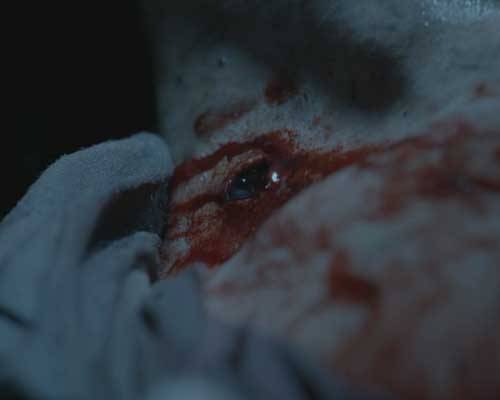
Claire promptly blasts the men with a list of required medicaments to treat the nasty wound but they’ve got nuthin’ ‘cept a cache of beloved whisky – no problemo!
Here ye go!
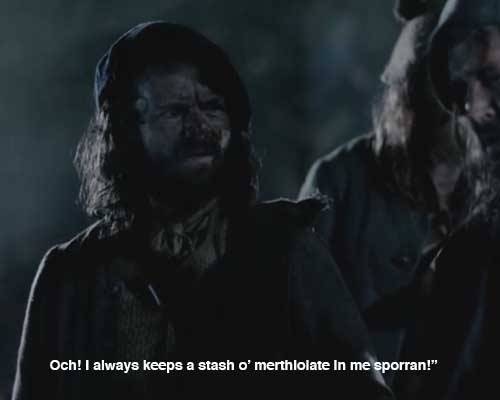
Now, back at triage, our BAD, SASSY LASSIE breaks into a litany of cussing and swearing and telling the men where they can stick their 18th century ideas (because, really, they’re no much help at all) and manages to even shock corn-grinding Uncle Dougal!
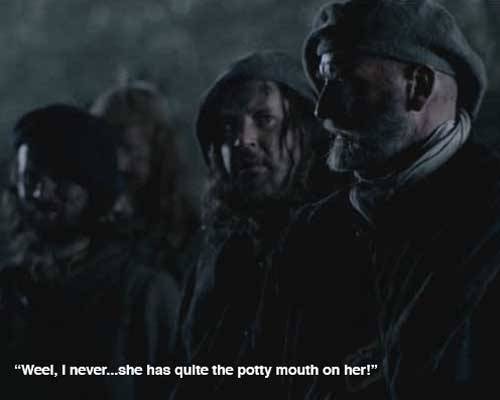
She none too gently rouses Jamie by pouring alcohol (yikes!) directly on his wound and then declares if he “so much as moves a muscle, she is going to bloody throttle him!”
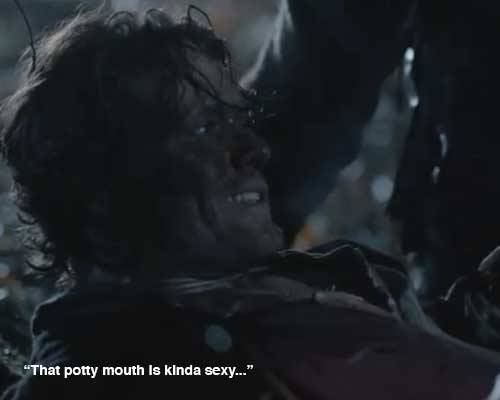
Our Sassynach later asks Jamie. “Does it hurt now?” as she deliberately tugs the dressing to make damn well sure it does hurt. Learn this lesson, Jamie: when Nurse Claire is on duty, you will take care of that bloody dislocation!
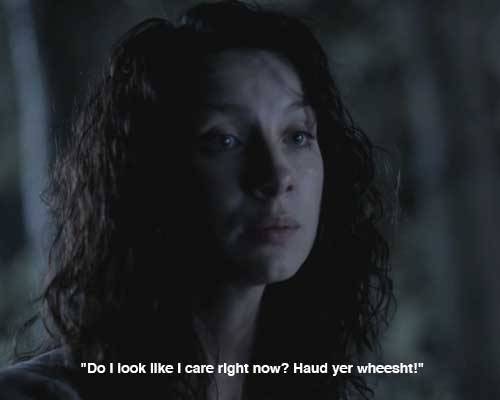
“Aye” mutters Jamie, but he’s really thinking…
tcha, she’s a feisty lass wit’ a tongue like an adder..but verra bonny!
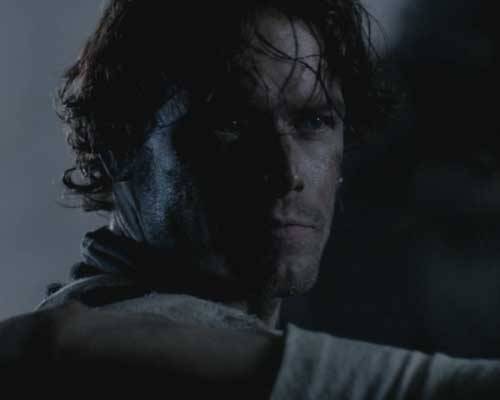
Now, just take a gander at the gleam in Jamie’s eyes during this whole scene! What was he thinking of this fierce feline? We learn in the Outlander book that he says to himself to himself says he:
“Jamie, lad, if her touch feels so bonny on your collarbone, imagine what it might feel the lower down…”
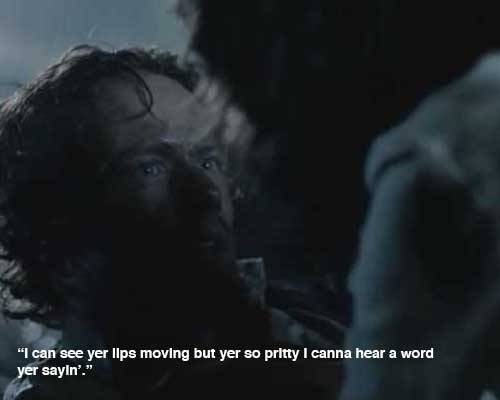
Trapezius: OK, the ball pierced the trapezius: what is the trapezius muscle and what is its purpose? The most superficial muscle of the back, each trapezius is large, flat, and shaped like a triangle with its base running from the back of the skull (green arrow in image D – left trapezius only) down the spine to the 12th thoracic vertebrae (T12). The muscle fibers then converge at the shoulder where they attach to scapula and clavicle. Together with its pair of the opposite side, the trapezii (pl.) create a 4-sided figure, hence the name trapezius (Greek meaning four-sided).
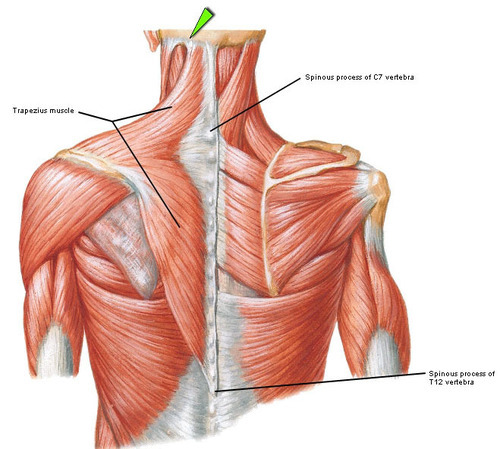
Image D
When viewed from the front the trapezius also forms the slope from neck to acromion (shoulder point). The green arrow in Image E marks the spot where the musket ball traversed Jamie’s right trapezius!
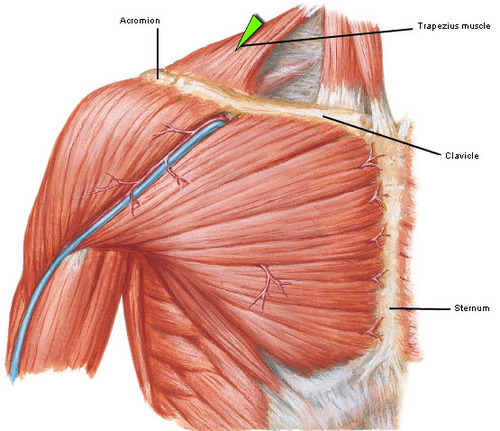
Image E
Understand that the shoulder is not fully functional without an intact trapezius because this powerful muscle lifts, depresses (pull downwards), retracts (pulls back) and rotates the scapula. A warrior could not be a warrior without a working trapezius! This is why Claire is soooo anxious to treat the wound properly and restore the trapezius to good health (because she is a nurse after all and her patient’s wellbeing comes first – never ye mind that she’s feeling a good deal more than just wellbeing for Jamie). Something’s cooking and it isn’t haggis!
So, Claire administers a field dressing using slip strips (pretty much all western women wore them in the 40’s) and off they go, again! They barely arrive at Castle Leoch (Starz, episode 2) ere her bonny fingers are again managing Jamie’s bonny collar bone and trapezius!
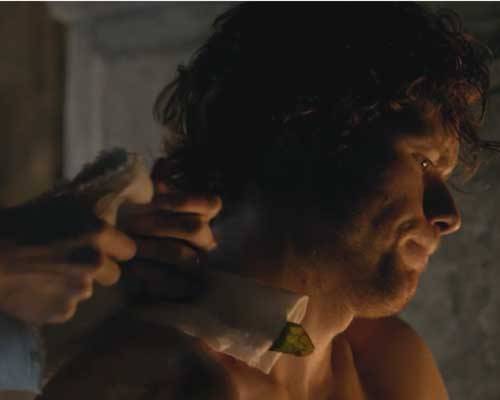
But, she purposefully hurts Jamie a second time by pulling his bandage so tight he can scarcely breathe (did you hear the linen strain?). Oooh, Mistress Beachamp…did he get too close for comfort, saying you are a kind woman with a good touch and old Frank was one damn lucky man? Don’t want him making any attachments or asking too many questions, aye? Must stay focused on the patient’s wellbeing and all that blatty-blah!
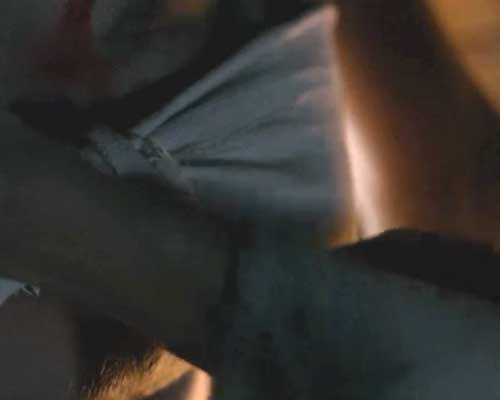
Now, a note of praise to the details crew of Starz episode 2, Castle Leoch… take a wee peek at Jamie’s shoulder as Claire removes the blanket covering his back. The exit wound is evident on the back of shoulder along with whiplash scars, but did you notice the ecchymosis (purple, blue, green and yellow discoloration) over the shoulder region (blue arrows)? This is mostly due to the dislocation and is absolutely realistic! But, as both wounds tear blood vessels, blood seeps into the soft tissue under the skin with the resultant mottled bruising. Nice job, folks! You hare redeemed for the fainting faux pas <g>.
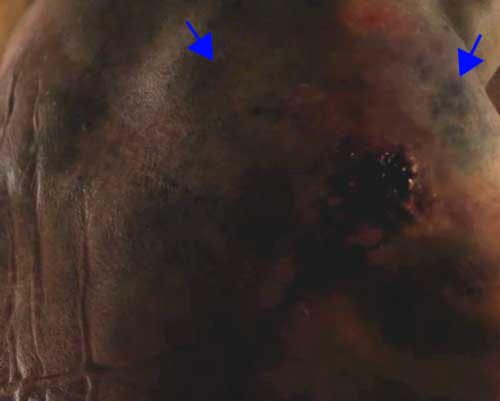
Lastly, I was delighted by Starz episode 7, The Wedding, where a faint scar from the gunshot wound can be seen just above Jamie’s right collar bone. Och! There goes MY blood pressure again!
Again, kudos to the detail people because most assuredly the scar should have been visible that soon after the injury.
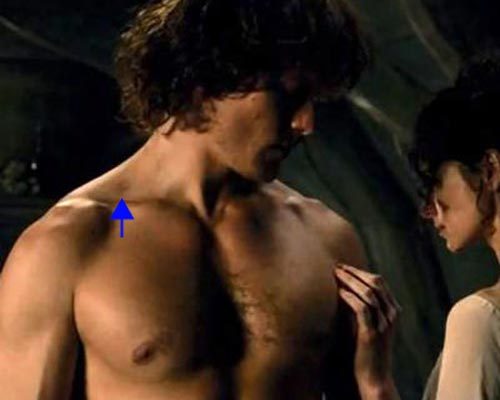
End: Let’s end with a wee history lesson: do you know the University of Edinburgh, Scotland, produced many of the most famous physicians and anatomists of western medicine? One of the better known is John Hunter (1728-1793), who became personal surgeon to King George III.
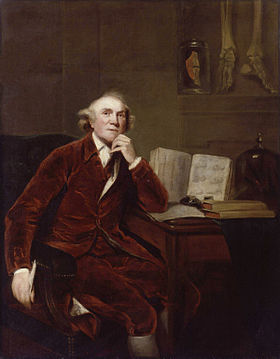
As a physician, he also revolutionized the treatment of gun shot wounds and made major advancements in the field of OB-GYN, bone growth, etc. As an anatomist, he amassed a collection of over 14,000 anatomical specimens, now housed in the Hunterian Museum at the Royal college of Surgeons of England, London. One of the specimens includes the skeleton of a 7’ 7” Irish giant by the name of Charles Byrne, showing that Herself was not off the mark by imagining a bonny, 6’ 4” Jamie!
Now, fare-thee-well to all of you until my next lesson. Take care of your own bonny clavicles and trapezii muscles!
Like you, I am counting down the days: 165 days until Starz Episode 9! Hang in there friends of Outlander Anatomy! United we STAND!
The deeply grateful,
Outlander Anatomist
All photos are credited to Starz or Frank Netter’s Atlas of Human Anatomy, 4th edition, except Ferris Bueller…I don’t know who took that picture but credit goes to the photographer who did back in 2006.
Haha. Just joshing. Claire doesn’t meets Jamie at a joint. Claire meets Jamie because of a joint! Welcome to Anatomy Lesson #2, the shoulder joint. Now, hold on just a sec, please don’t leave this lesson! This is great stuff – truly – and I promise to keep it interesting. I’ll even throw in a gratuitous shot of our favorite #JAMMF just to hold yer interest! Hee, hee, here ye go…
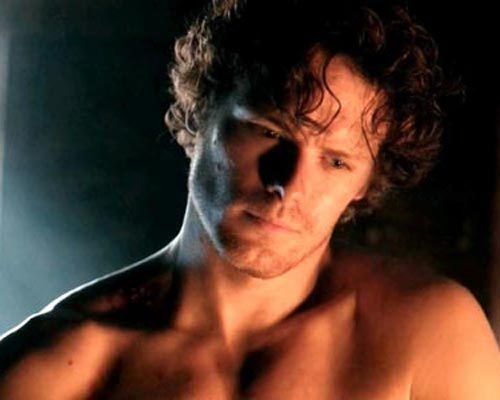
Better? Great! So, in Starz episode 101, Sassenach, Claire first sees Jamie seated on a low stool in a dimly-lit cottage. He is in pain. Herself enlightens us in Outlander book:
a dreadful hump rose on that side, and the arm hung at an impossible angle.
Now, what is the dreadful hump, what might have caused it, and how might it be resolved?
Anatomy to the rescue! Yep, it explains everything!
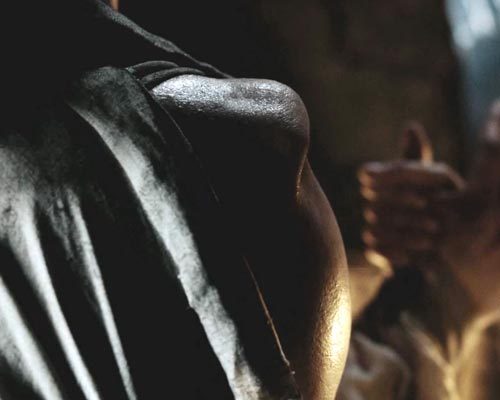
Hump: The hump is an bony part of the shoulder joint. The should joint is an essential part of each upper limb. Let me assure you, its anatomy is absolutely awesome! First, it is the MOST moveable joint of the entire human body (think of the shoulder joint during slow pitch or with a butterfly stroke). Second, the shoulder joint is a slightly misleading term because it is not one joint, but two – the glenohumeral joint and the acromioclavicular joint:
Together both joints form the “shoulder joint!”
Glenohumeral Joint: At the glenohumeral joint, the head of humerus moves in the glenoid cavity (a.k.a. glenoid fossa), a small and shallow socket on the side of scapula.
The good news: because the glenoid cavity is shallow, the humeral head is highly moveable allowing for at least nine different defined motions.
The bad news: unfortunately, the shallow socket also allows the head of humerus to dislocate with relative ease! Get it? Grand!
Turns out that puir Jamie dislocated his glenohumeral joint (Image A – green arrow, right front view). Och!
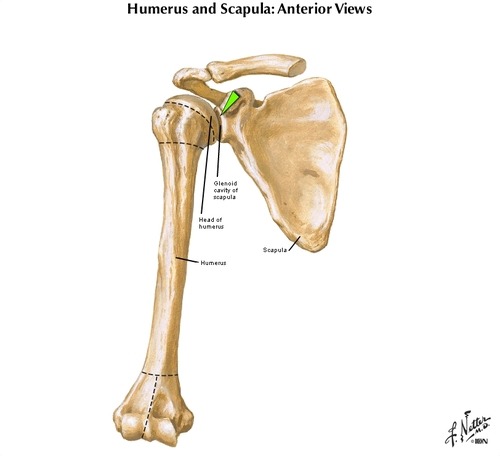
Image A
Acromioclavicular Joint: The acromioclavicular joint (green arrow in Image B – right front view) is a tight joint between acromion (also part of scapula) and clavicle. The clavicle acts as a strut holding the acromion away from the torso. Associated muscles contract to adjust positions of both clavicle and scapula (e.g. up, down, back, forward). And, amazingly, the acromioclavicular joint also guarantees greater range of motion at the glenohumeral joint.
Try this: Place fingers of one hand on the contralateral (opposite) clavicle. Now, move clavicle forward, backward, up, down. Now, roll it forward (as in doing the hoochie koo) and then backward. See how mobile the clavicle is? Amazing!
Now, move fingers to the scapula of the same side and repeat the same clavicular (adj.) movements. See how the scapula is carried along with the clavicle? This occurs because they are united at the acromioclavicular joint! And, increased scapular mobility means increased mobility of humerus as it is concurrently moved at the glenohumeral joint. Normally, the whole apparatus works together like a finely-oiled machine.
So, for example, each time you lift the clavicle and scapula, you can also raise your arm higher. Prove this to yourself: hold your scapula still and raise the arm of the same side. Find that you cannot raise the arm very high, but once you release the scapula to lift, the humerus can be raised to the full vertical position. Hoping this makes sense!
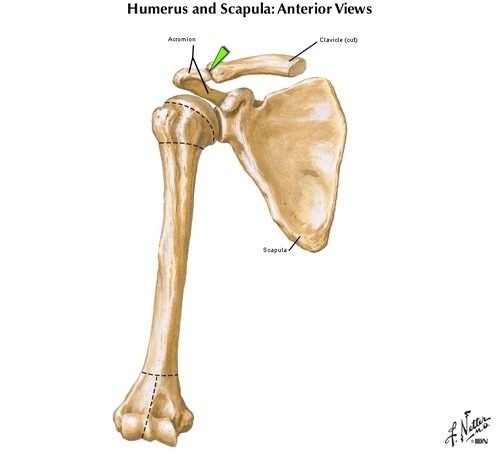
Image B
Acromion: The acromion (Image C – right back view) overreaches and protects the underlying glenohumeral joint. Acromion shares the same Greek word root with the Acropolis of Athens, meaning “peak” because both structures overlook what lies below. In lay terms, the acromion is better known as the “point of the shoulder.”
The “dreadful hump” on Jamie’s right shoulder is his right acromion, left high and dry because the humeral head is no longer in its socket (glenoid cavity). Gah! Deprived of the rounded contour normally provided by the humeral head, the acromion is revealed as a huge bulge of the shoulder area.
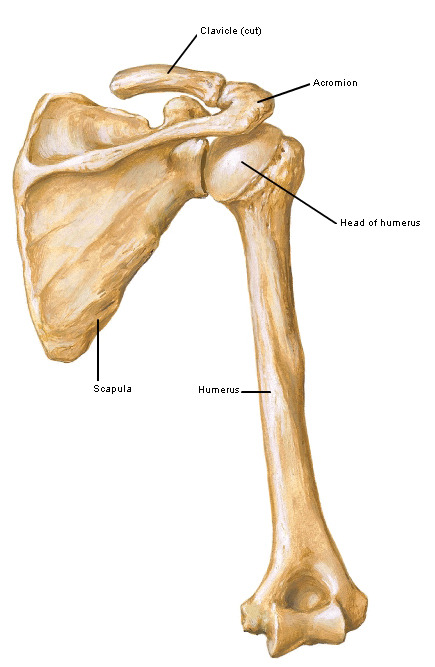
Image C
Try this: Palpate the point of one shoulder and feel the big bony chunk; this is the acromion of scapula. Now, check this area out on your wee dog or perhaps on a horse (‘cuz Jamie does like the horsies)! The acromion faces forward, coming to lie under the neck of these animals. Why? Because dogs and horses have no clavicles to hold the shoulder joint away from the torso, so, the entire scapula and its acromion are located on the sides of their chests – ours are on our backs.
The Bottom Line: Glenohumeral joints of dogs and horses are much more stable than ours but their range of motion is also greatly limited. We don’t see dogs running with front legs whirling like windmills. The photo is of a Vizsla, BTW.
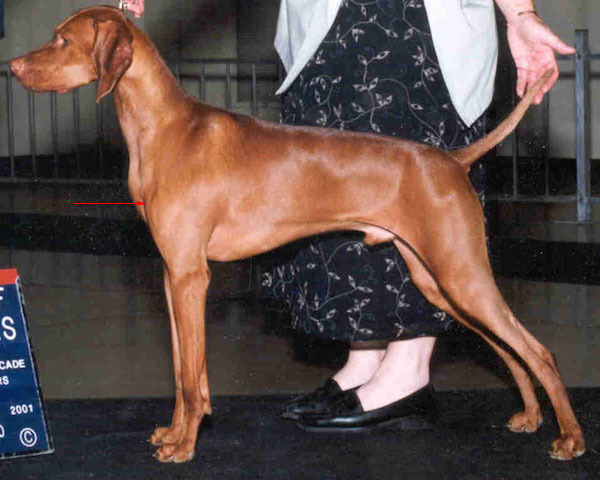
Rotator Cuff: Now, if the glenohumeral joint is relatively unstable, what holds it in place? This is accomplished by some very strong ligaments and four muscles forming the rotator cuff. Also, the powerful deltoid muscle (Image D – green arrow denotes head of humerus) covers the joint, ligaments and part of the rotator cuff with a thick, protective muscular padding (especially in a lad like Jamie – <G>!).
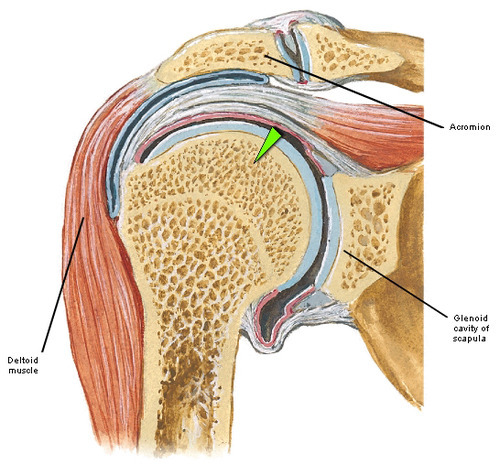
Image D
Ok, I can tell I am losing you. Wake up! Here, have another dose of our gorgeous hero!
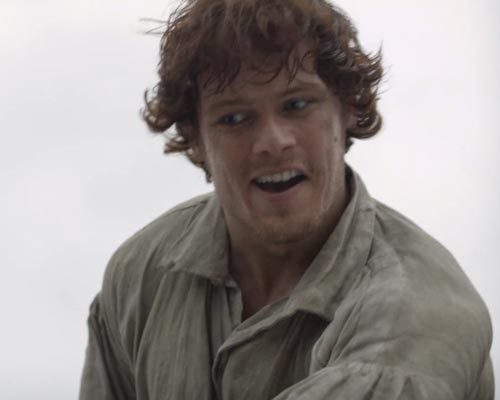
Now, back to Starz episode 101, Sassenach: We hear the ever “tender” uncle Dougal mutter ”it’s out-o-joint, poor bugger.” Well, duh!
In Outlander book, Jamie explains:
I fell wi’ my hand out, when the musket ball knocked me off my saddle. I landed with all my weight on the hand, and crunch!, there it went.
Now, folks, falling on an outstretched arm/hand is the classic cause of an anterior dislocation of the glenohumeral joint, wherein the humeral head is thrust forward (anterior) and out of the glenoid cavity. This stretches and tears ligaments and muscles and, sometimes, cartilage.
Back to episode 101, Sassenach… Our favorite goof, Angus, delicately raises one brow and declares in his best practitioner’s voice:
I’ll have to force the joint back!
Yeah, right, Angus! He and his brawny pals start forward only to be stopped in their shoon by awesome Claire using her best Hospital Matron voice:
Don’t you dare…stand aside at once!”
She then enlightens Dougal, who, no doubt, is one of the brighter bulbs in that crofter’s cottage:
You have to get the bone of the upper arm into the proper position before it slips back into joint.
Now, at this point, our sweet hero is looking a wee bit dubious about this whole “girlie” thing. Well, it’s either Claire or Angus. Who would you choose? I’d go with the shift, too, sweet lad.
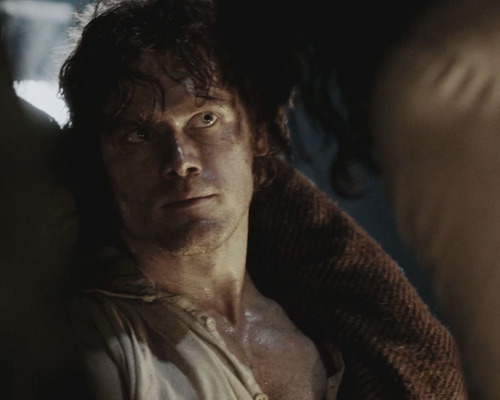
After obtaining Jamie’s nod of assent, Claire grips his right wrist in one hand and his bent elbow in the other. Lifting with considerable effort, she rotates his forearm to his right side (external rotation), a maneuver that aligns the humeral head with glenoid cavity.
The considerable resistance Claire encounters (just look at our strong, winsome heroine!) is due to swollen muscles, torn ligaments, and the weight of his “heavy as lead” arm!
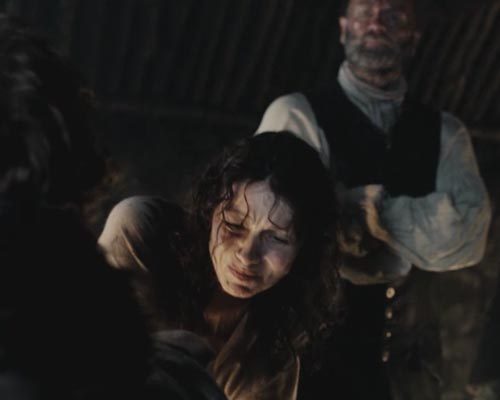
Then, warning Jamie that the worst is yet to come, Claire holds his bent elbow against his torso, and gripping his right hand, rotates his forearm to his left (internal rotation), a maneuver designed to reseat the humeral head in the glenoid cavity!
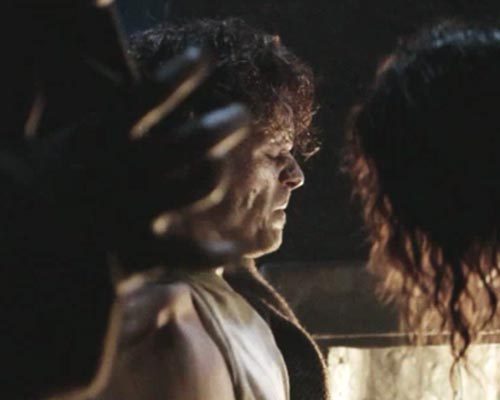
Suddenly, Jamie’s shoulder gives a soft, crunching pop as the humeral head slides home into the glenoid cavity and the dislocated joint is reduced. And, folks, it hurts, especially several hours post-injury – truly! Kudos to the special effects crew for the CGI/prosthesis!
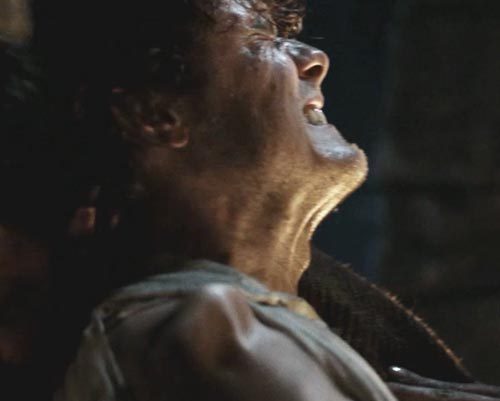
Just ask Angus…Och!
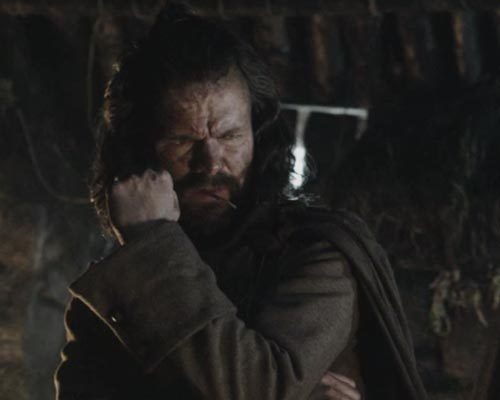
Next and this is very sweet, Jamie says he’s
takin’ a guess she’s done this afore.
Trust me, Claire assures him:
I’m a nurse!
Har, har! Jamie eyes immediately drop to her bosom and he responds:
Aye.
Ah, well, he may be injured, but his other brain seems intact! What was he thinking’? Do me eyes behold a sweet avenging angel? A wee demon? A biting vixen? But, whatever she is, thank the stones she’s NOT A WET NURSE!
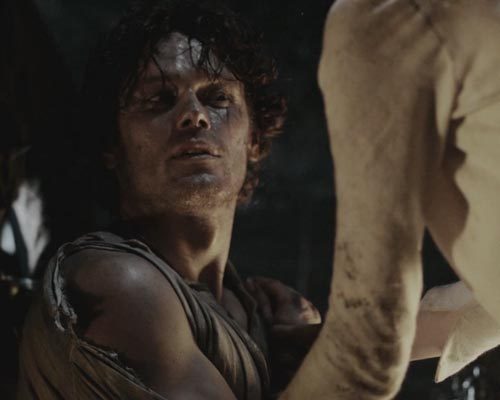
Now, just in case ye missed it, take a look at Claire’s eyes when she sees Jamie’s muckle size as he rises off the stool. She even has the good sense to blink a few times. Yup, he got her attention alright and she got his. There’s a sizzle on the griddle, now!
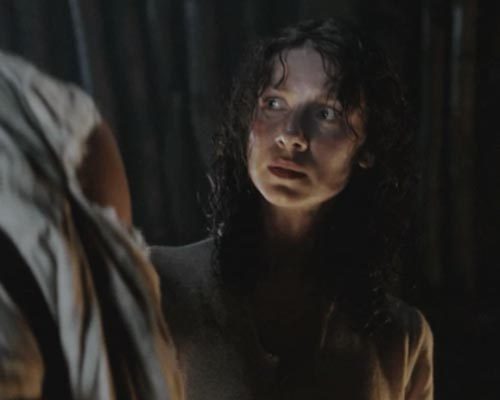
Fun Fact: Did you know that Claire could have employed a much older method of reducing Jamie’s dislocation? Hippocrates (460-370 B.C.), father of western medicine, devised the Hippocratic maneuver, wherein the practitioner places the heel of his/her foot into the armpit of the dislocated side and pulls on the corresponding wrist to reduce the dislocation. I would love to see Claire pull that one off! Without a doubt, she is flexible enough to stick her foot in Jamie’s oxter. Check out her graceful dismount from Jamie’s steed in the castle courtyard, Starz episode 102, Castle Leoch! Watch out, Rockettes!
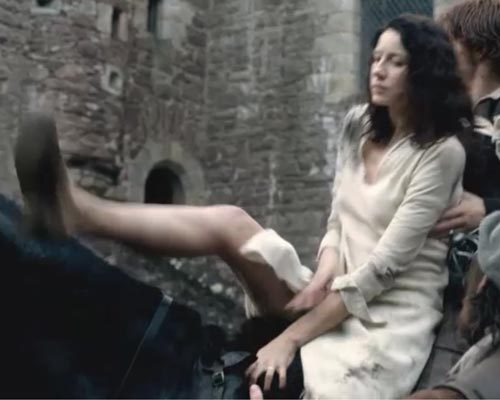
Realism: OK…question: was the scene from episode 101 realistic? Is it likely that a WWII combat-trained nurse such as Claire might know how to reduce the dislocated humeral head using the method shown? Oh, aye, because the procedure she employs looks verra much like the Kocher maneuver, developed in the 19th century by a Swiss surgeon of the same name. Although other reduction methods are now available, Kocher was widely used for over a century and Claire could very well have learned it in training or as a combat nurse.
Another realistic feature, check out Jamie’s eyes in episode 101. Throughout the entire scene, his pupils are VERY dilated. This is also highly realistic because the pain of dislocation would initiate the fright/flight/fight reflex, dilated pupil being a prime feature of that response! His pupils are soooo dilated that the rims of his irises are barely visible!
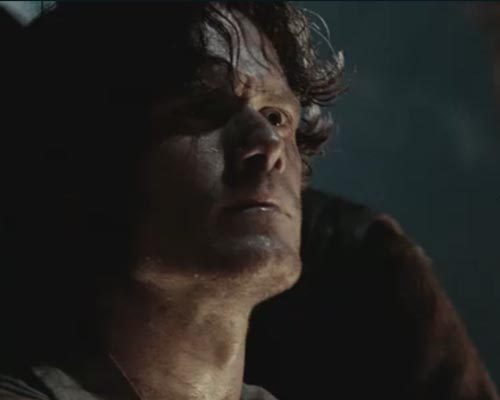
Overall, this vivid scene was realistic, dramatic, and extraordinary in most every detail. Congratulations to the cast and crew! If you readers are interested, here is a link to a YouTube demo of the Kocher reduction.
My next post may well review Jamie’s other injury sustained in Starz episode 101, Sassenach. Please stay tuned and see what’s next! After all, we have to keep engaged until April of 2015! Geez, Starz…soooo harsh!
Just for fun, consider a few shoulder idioms, use used to convey important emotions:
Yadda, yadda, yadda. You get the drill. Hope to see you at Anatomy Lesson #3!
The deeply grateful,
Outlander Anatomist
Photo credits:
Starz; Frank Netter’s Atlas of Human Anatomy, 4th edition, Outlander Anatomist private collection.